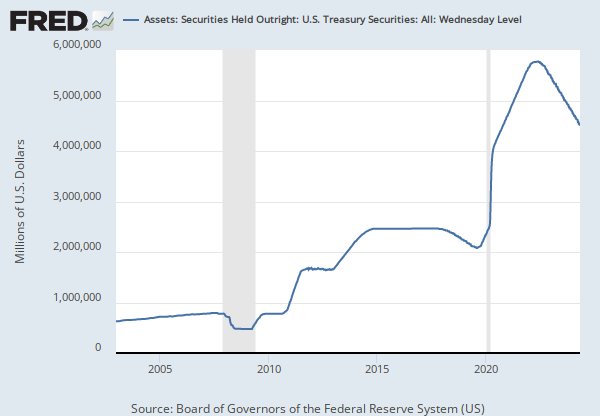Observations
2025-04-09: 0 |
Millions of U.S. Dollars, Not Seasonally Adjusted |
Weekly,
As of Wednesday
Updated: Apr 10, 2025 3:59 PM CDT
Observations
| 2025-04-09: | 0 | |
| 2025-04-02: | 0 | |
| 2025-03-26: | 0 | |
| 2025-03-19: | 1 | |
| 2025-03-12: | 1 |
Units:
Frequency:
Write a custom formula to transform one or more series or combine two or more series.
You can begin by adding a series to combine with your existing series.
Now create a custom formula to combine or transform the series.
Need help?
For example, invert an exchange rate by using formula 1/a, where “a” refers to the first FRED data series added to this line. Or calculate the spread between 2 interest rates, a and b, by using the formula a - b.
Use the assigned data series variables (a, b, c, etc.) together with operators (+, -, *, /, ^, etc.), parentheses and constants (1, 1.5, 2, etc.) to create your own formula (e.g., 1/a, a-b, (a+b)/2, (a/(a+b+c))*100). As noted above, you may add other data series to this line before entering a formula.
Finally, you can change the units of your new series.
Add the minimum, maximum, and average calculations of selected bars to the graph
Write a custom formula to transform one or more series or combine two or more series.
You can begin by adding a series to combine with your existing series.
Now create a custom formula to combine or transform the series.
Need help?
For example, invert an exchange rate by using formula 1/a, where “a” refers to the first FRED data series added to this line. Or calculate the spread between 2 interest rates, a and b, by using the formula a - b.
Use the assigned data series variables (a, b, c, etc.) together with operators (+, -, *, /, ^, etc.), parentheses and constants (1, 1.5, 2, etc.) to create your own formula (e.g., 1/a, a-b, (a+b)/2, (a/(a+b+c))*100). As noted above, you may add other data series to this line before entering a formula.
Finally, you can change the units of your new series.
Add the minimum, maximum, and average calculations of selected bars to the graph
Data in this graph are copyrighted. Please review the copyright information in the series notes before sharing.
Notes
| Title | Release Dates | |
|
|
||
| Repurchase agreements held by the Federal Reserve: Maturing within 15 days | 2010-02-04 | 2019-08-20 |
| Assets: Other: Repurchase Agreements: Maturing Within 15 Days: Wednesday Level | 2019-08-21 | 2025-04-10 |
| Source | ||
|
|
||
| Board of Governors of the Federal Reserve System (US) | 2010-02-04 | 2025-04-10 |
| Release | ||
|
|
||
| H.4.1 Factors Affecting Reserve Balances | 2010-02-04 | 2025-04-10 |
| Units | ||
|
|
||
| Millions of Dollars | 2010-02-04 | 2019-08-20 |
| Millions of U.S. Dollars | 2019-08-21 | 2025-04-10 |
| Frequency | ||
|
|
||
| Weekly, As of Wednesday | 2010-02-04 | 2025-04-10 |
| Seasonal Adjustment | ||
|
|
||
| Not Seasonally Adjusted | 2010-02-04 | 2025-04-10 |
| Notes | ||
|
|
||
|
Repurchase agreements reflect some of the Federal Reserve's temporary open market operations. Repurchase agreements are transactions in which securities are purchased from a primary dealer under an agreement to sell them back to the dealer on a specified date in the future. The difference between the purchase price and the repurchase price reflects an interest payment. The Federal Reserve may enter into repurchase agreements for up to 65 business days, but the typical maturity is between one and 14 days. Federal Reserve repurchase agreements supply reserve balances to the banking system for the length of the agreement. The Federal Reserve employs a naming convention for these transactions based on the perspective of the primary dealers: the dealers receive cash while the Federal Reserve receives the collateral.
|
2010-02-04 | 2025-04-10 |
Release Tables
Permalink/Embed
modal open, choose link customization options
Select automatic updates to the data or a static time frame. All data are subject to revision.









